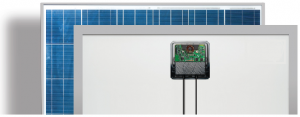Tigo Energy provides power optimisation solutions for residential, commercial and utility-scale solar photovoltaic (PV) projects, allowing owners to get the most of their solar power systems. The company was formed in 2007 in Los Gatos, California by Silicon Valley innovators with the intention of developing solutions to several problems associated with the traditional interconnection of solar PV panels. The result was the Tigo Energy Maximizer system, available as a panel-integrated solution or as a system add-on. The Maximizer system has been rolled out across the US, Europe, Japan, Korea, the Middle East, and is now available in Australia.
Tigo Energy Products
Tigo Energy’s signature products are its Maximizers, of which there are two lines. One, for integration into individual modules, is called the Module Maximizer (a Maximizer-integrated panel is also referred to as a ‘Smart Module’). The other, called the Dual Maximizer, can be installed at a ratio of either 1 for 1 solar panel or 1 for 2 solar panels, usually on the system’s mounting brackets. Both of Tigo’s Maximizer product lines can help to enhance system yields–especially where shading is a potential issue–and allow owners to monitor the performance of their solar systems in more detail than a conventional solar system arrangement would. Both also include safety features that allow panels to be deactivated individually, lowering the voltage of the system as a whole to that of a single panel. This is useful for maintenance or in the event of a fire at the property.
Tigo Energy Module Maximizer (Smart Modules)
Tigo does not manufacture its own solar panels; instead the company works with leading solar manufacturers to develop Smart Modules. The list of solar panel manufacturers involved with Tigo includes Hanwha (owner of Q. Cells), Upsolar and Trina Solar, who integrate the Maximizers into their modules. Certifications are awarded in conjunction with Tigo’s partners. A full list can be found on their website (www.tigoenergy.com). 
Tigo Energy Maximizer integrated into a solar panel
The benefit to consumers of investing in Smart Module technology includes: greater power density / efficiency, which in turn improves return on investment (ROI); the ability to monitor performance at the module-level for speedy identification of poorly performing panels and other troubleshooting; increased safety and hazard mitigation; and a simplified balance-of-system design. Download the data sheet: Tigo Energy Module Maximizer – ES (MMJ-ES) (pdf)
Tigo Energy Dual Maximizer
The Tigo Energy’s Dual Maximizer can be retrofitted to existing systems or installed during the fitting of traditional panels, using either a 1:1 or 1:2 Maximizer to panel ratio. The Dual Maximizer offers customers the same features and benefits as the Module Maximizer: greater power density, safety features, superior performance in shading, and so on. The key difference is that the Dual Maximizer is an addition to the system and needs to be installed separately from the panels. Download the data sheet: Tigo Energy Dual Maximizer (pdf) 
Tigo Energy’s Dual Maximizer
Tigo Energy Maximizer system
The functionality of Tigo’s Maximizers is enhanced when coupled with the company’s Maximizer Management Unit (MMU). With the MMU, customers can access data about individual solar modules via an online portal. (An example of the interface is shown below.) Alternatively, smart phone customers can access the data and manage their system via a mobile application. 
Tigo Energy’s Module-Level Monitoring interface
In order to access this information remotely, the Maxmizer system requires the installation of a ‘Gateway’. Each Gateway can communicate with up to 120 modules and the MMU. The MMU coordinates data exchange between with the Maximizers and the inverter using a wireless connection. It sends information collected from the Maximizers to a remote server accessed through an online portal or mobile application, and relays any information from the system manager back to the Mazimizers. Lastly, the company offers a Smart Combiner Box, which offers additional monitoring and safety features in additional to the ‘standard’ options available through the Smart Modules and Dual Maximizer. Images via Tigo Energy © 2013 Solar Choice Pty Ltd
- Solar Power Wagga Wagga, NSW – Compare outputs, returns and installers - 13 March, 2025
- Monocrystalline vs Polycrystalline Solar Panels: Busting Myths - 11 November, 2024
- Solar Hot Water System: Everything You Need to Know - 27 February, 2024
My batteries are 10 pcs 12 volts of 200Ah each connected in series to 120 vdc through invertor I get 220vac for my domestic load of 2 ACS x 1.5 tons run for 7 hours at night only, 2 fridges 8 cft each,
Daytime 10 bulbs, 2 fans, PC, Microwave oven 2 min 5 times a day.
I have following configuration
Alpex Solar panels 250w x 20 pcs connected as 10x12v two sets in parallel to deliver 120v. Panel spray cleaning for dust removal installed.
Charging unit to take in charge and store in
10 pcs 12 volt solar compatible batteries of 200 ah each.
7500 watts Inverter to deliver 220 volt power.
System not connected to grid but with
With battery draining below 110 v inverter cuts off and grid power comes in action. But when battery charges over 130 volts does NOT change over to invertor.
I get only 8 units kwh per day only. Explain?